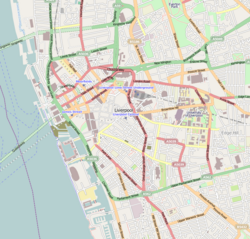India Buildings
| India Buildings | |
|---|---|

India Buildings
|
|
| Location | Water Street, Liverpool, England |
| Coordinates | 53°24′22″N 2°59′33″W / 53.4061°N 2.9926°WCoordinates: 53°24′22″N 2°59′33″W / 53.4061°N 2.9926°W |
| OS grid reference | SJ 341 904 |
| Built | 1924–32 |
| Built for | Blue Funnel Line |
| Architect |
Arnold Thornely and Herbert J. Rowse |
| Architectural style(s) | Italian Renaissance with American Beaux-Arts features |
| Governing body | Green Property |
|
Listed Building – Grade II*
|
|
| Official name: India Buildings, including the Water Street entrance to James Street underground station | |
| Designated | 5 November 2013 |
India Buildings is a commercial building with its principal entrance in Water Street, Liverpool, Merseyside, England. Mainly an office building, it also contains an internal shopping arcade and the entrance to an underground station. It was built between 1924 and 1932, damaged by a bomb in 1941, and later restored to its original condition under the supervision of one of its original architects. The building, its design influenced by the Italian Renaissance and incorporating features of the American Beaux-Arts style, occupies an entire block in the city.
India Buildings was built between 1924 and 1932. The competition for its design was won in 1923 by Arnold Thornely and Herbert J. Rowse, the assessor being Giles Gilbert Scott. It was built as a speculative venture by the shipping firm of Richard Durning Holt and Alfred Holt and Company (the Blue Funnel Line) partly for its own use, and partly for letting offices to other businesses. It was built by Dove Brothers of Islington, its steelwork being made and erected by Dorman Long of Middlesbrough. The cost of the building was £1.25 million (equivalent to £78,260,000 in 2015). The building replaced an older one on the site known as "India Building", built in the 1830s for George Holt, the father of Alfred. The new building was constructed in two stages, the first stage being alongside the earlier building, and the second stage demolishing and replacing it. The two stages straddled the former Chorley Street. Before the design was approved, Liverpool Corporation stipulated that an arcade of shops should run through the centre of the building on the route of the street, and this was incorporated into the design. The original occupants included Lloyds Bank, a Post Office, commercial and insurance companies, solicitors, and government offices. Alfred Holt and Company occupied most of the sixth, seventh and eighth floors. Also in the building were a public hall and a constitutional club. India Buildings was badly damaged by bombing in 1941, and was later restored to its original condition under the supervision of Herbert J. Rowse.
...
Wikipedia

